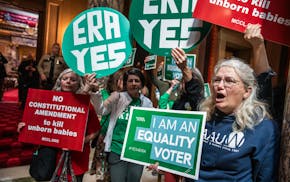Last week, the Ohio Legislature passed a law banning abortion after the first fetal heartbeat can be heard. Texas enacted rules requiring that aborted fetuses be buried or cremated. And in Louisiana, a private trust purporting to act on behalf of 5-day-old frozen embryos sued the actress Sofia Vergara demanding that they be implanted in a uterus so they could be born.
All three developments are legally questionable, to say the least. The Ohio bill, which was vetoed Tuesday by Republican Gov. John Kasich, was in my view clearly unconstitutional; the Texas law may be, and the Louisiana lawsuit would cause upheaval in the assisted reproduction community should it succeed. Yet all three signal the durability of the idea that the unborn have legal rights — a position the U.S. Supreme Court has never adopted.
The Ohio heartbeat bill was an open challenge to the Supreme Court precedents of Roe vs. Wade and Casey vs. Planned Parenthood. The bill said it was illegal to perform an abortion before determining whether a fetal heartbeat can be detected, and that it would be a crime to perform an abortion if the heartbeat can be heard. Although there is an exception to protect the pregnant woman's life or "major bodily function," the law tried to move the date for the last legal abortion from viability — about 24 weeks gestational age — to about six weeks, when the heartbeat can usually be detected.
If tested in court, the bill likely would have been struck down as unconstitutional. But its mere passage signals something more deeply cultural: the use of fetal heartbeat as a tool to convince people that a fetus should count as a human life.
It's noteworthy that the bill deviated from the classically Catholic idea that life begins at conception. If life begins then, there's nothing theologically or morally special about the detectability of the heartbeat. And I'm not aware of any religious or legal tradition that treats heartbeat recognition as theologically salient.
In contrast, quickening — when the mother feels the fetus moving, anytime from 13 to 22 weeks — has a long history of religious and legal significance. The heartbeat, detectable using modern medical technology, gained salience as part of the pro-life movement's efforts to fight Roe and abortion rights. Now that relatively recent cultural phenomenon is getting a legal significance.
The Texas administrative rules, issued by the state's Department of Health Services, require that medical facilities arrange cremation or burial for fetuses or parts of fetuses generated by "spontaneous or induced human abortions, regardless of the period of gestation." It's disputed what the costs will be, or whether they will be passed along to women seeking abortion — and that will matter for the law's constitutionality.
Under the decision issued in June in Whole Women's Health vs. Hellerstedt, a law unduly burdens abortion rights if it imposes costs that exceed its health benefits. If the Texas rules raise the cost of abortion, they will violate that decision, because they don't add any health benefits. If, however, the rules have no effect on cost, the law might not be unconstitutional as an undue burden.
If the rules in fact impose no extra costs, then they, too, must be understood in symbolic terms. In brief, their purpose would be to signal that unborn fetuses must be considered a form of human life deserving of the dignity of burial or cremation. This is not a religious-doctrinal argument, so far as I can determine, although some Catholic cemeteries have separate sections for miscarried fetuses. Rather, like the Ohio law, it seems to be an outgrowth of the pro-life struggle to get fetuses recognized as human life.
The suit against Vergara on behalf of two cryopreserved, 5-day-old embryos goes even further. The embryos were created by Vergara and her then-fiancé Nick Loeb; after their breakup, Vergara has chosen to keep them frozen.
The lawsuit was filed on behalf of the embryos by a Louisiana-based trust that says it was created to benefit the embryos, which the suit refers to as Isabella and Emma. The connection to Louisiana seem to be tenuous, as the embryos are frozen in Los Angeles. The lawsuit says only that Loeb and Vergara "ended their relationship" in Louisiana.
What's striking about the suit, of course, is that it wasn't filed on Loeb's behalf but on behalf of the embryos. Thus, before considering any legal claims, a court considering the suit would have to determine that embryos possess legal interests — and that the embryos' best interest is to be born.
This would be a revolutionary holding, which would substantially disrupt assisted reproduction as it's practiced all over the country. Embryos are treated now as parental property, not as independent entities. For that reason, a court — even in conservative Louisiana — is pretty unlikely to entertain the suit.
The suit therefore should be interpreted in cultural terms. If fetuses are considered to be fully human, then embryos presumably wouldn't be far behind. And once they are considered humans, they must have interests. Instead of viewing the embryos as part of the parents' chosen efforts to reproduce or not, the suit aims to recenter that vision and consider the embryos as tiny humans just waiting to be born.
The Supreme Court's abortion cases have never defined fetuses (much less embryos) as humans with interests. Roe vs. Wade held that "the word 'person,' as used in the Fourteenth Amendment, does not include the unborn." That has remained the cornerstone of the constitutional abortion right.
Yet over time, the court's jurisprudence must come to terms with cultural impulses running the other way. For anyone who supports abortion, the persistent fetus initiatives are a serious challenge.

Divestment is easier chanted than done
Pass guardrails for HCMC governance changes

Minnesota needs an ERA that includes gender and reproductive freedom

Legislature must clarify sex, gender before putting an ERA before Minnesota voters
